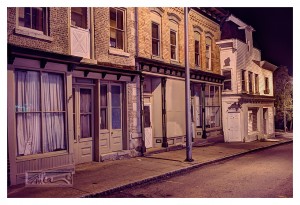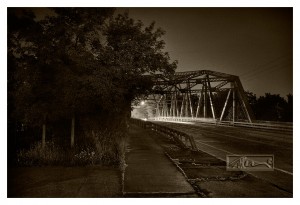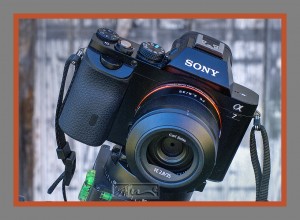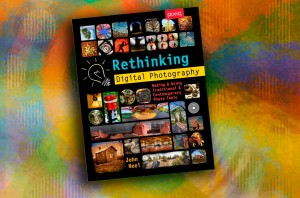
Side Street – © John Neel with Sony a7
“The Sony A7 and Sony A7r are two great examples of new camera designs that have evolved into the kinds of image-making tools that manufacturers are creating for us today.”
When I was at Kodak, I worked within Corporate Design and also in what was known as the System Concepts Center.
As someone who created concepts and inventions for digital cameras, human factors became one of many tasks. It was important to consider usability and user interface for any concept we might have imagined.
In designing anything, usability is what you try to incorporate into the thing being designed. Functionality is always more important than what a product looks like. In design, form always needs to follow function. When done correctly, form is actually defined by the functionality. The thing being designed needs to meet the needs of the user.
As digital cameras became more ubiquitous, they also seemed pretty difficult to operate. In part, the industry was still trying to evolve the user experience of a new type of image-making device. For some reason, digital seemed to imply something very different in terms of user expectations.
Digital photography seemed to follow some weird logic in its evolution. In trying to create a new paradigm, the makers made them unfriendlier than their film counterparts. Early digital camera design wanted to be futuristic and as a result, the user interface was created in an awkward fashion. Some of that design was probably unavoidable in getting the digital ball rolling.
Please read – Disclosure
All along, I believed that digital cameras needed to follow the functionality of traditional film cameras such as those on Nikon, Canon, and Pentax SLR cameras or Leica Rangefinders. Mainly, they needed to be simplified, and that dials and buttons needed to be outside of the camera display, on the top-plate where they could be easily accessed and easily operated. It made sense to have one dial for aperture control and one dial for shutter control as well as other buttons and dials that one might need immediately for controlling the exposure.
Instead, they designed the interface to be run electronically through a pretty confusing array of digital menus. The first attempts at digital display were done with cumbersome LCD menus that one had to scroll though and set individually. Early digital cameras incorporated an arrangement of buttons to navigate a series of quirky digital commands shown on a funky liquid crystal display. Besides the buttons being somewhat confusing, they were also laid out in typically awkward positions on the camera body. The camera designers seemed to focus more on the idea of a camera as computer rather than the concept of camera as a system of aperture and shutter controls.
That evolution was probably unavoidable in that much of the technology that we are used to today had not yet been invented. Sensors were a new concept and so were displays. High-resolution sensors that we take for granted today were not possible due to the extremely limited processing capabilities of the period. Cameras produced very tiny images with very small sensors and very slow CPU capability.
In recent times the evolutionary path has come back to a more suitable way of producing the results people need in their image-making. Things have now become very much like the film cameras of the past.
Cameras today are as easy to use as their counterparts from a few decades back in photographic history. In most cases, they are much easier to use due to the vastly improved systems, displays, controls and user interfaces. Cameras can now do what we couldn’t have dreamed of only a few short years ago. Most of this new technology has evolved in ways that most users can never fully appreciate. Most of it is simply taken for granted. Most of it is simply viewed as what a camera does. It is hard for many to understand that cameras were not always digital or very much at all about the history of imaging.
From what I can tell, mirrorless cameras are quickly becoming the norm for most new users. The idea of a mirrorless camera has opened up many new options. One of the best is the ability to use what some call legacy glass. Many older lenses can be used due to the shorter flange to sensor distance of mirrorless design. Another is the compactness of the design for ease of carry and handling.
The Sony a7 camera, as one example, is a beautiful illustration of how well the mirrorless design has been able to incorporate more user capability into a small layout. To me, the Sony a7 camera is a dream come true. It looks and feels almost exactly the way I had envisioned the future of digital cameras when at Kodak. Everything is where it needs to be. The camera is intuitive and smart. For those who have used the past as a reference, it doesn’t take much to understand the interface.
User interface is critical to ease of use and functionality. It was silly that early cameras required one to go into a menu to set the aperture or the shutter. It was also silly that a camera should be controlled by using an interface that took you completely away from the task of shooting the subject. Yet, in the early history of digital cameras, the settings for most cameras was set through the menu interface. Dials and wheels it seems, were an afterthought adaptation from the days of film. They gave the camera much more functionality and made the act of photography much more intuitive.
Please read – Disclosure
The Sony A7 and Sony A7r are two great examples of new camera designs that have evolved into the kinds of image-making tools that manufacturers are creating for us today.
These two cameras are amazing examples of what I had been thinking about years ago. While there are a number of cameras that evolved in similar ways to what I had envisioned, the Sony A7 series is one that I am most recently familiar. In my experience, the a7 has met most if not all of the criteria I was hoping for.
Part of that dream was to have the speed and power to make gigantic imagery and to do it with a well designed instrument.
While it is important to think forward, there are many lessons to be learned from realizing our past. The past has answers worth adopting into the future of making photographs. It has answers for moving camera design forward.
A link to an earlier post – Sony A7 Pretty and Pretty Perfect
I cover many photographic topics and techniques in my book. – Great Photography book for any creative Photographer.
Rethinking Digital Photography – John Neel
NOTICE of Copyright: THIS POSTING AS WELL AS ALL PHOTOGRAPHS, GALLERY IMAGES, AND ILLUSTRATIONS ARE COPYRIGHT © JOHN NEEL AND ARE NOT TO BE USED FOR ANY PURPOSE WITHOUT WRITTEN CONSENT FROM THE WRITER, THE PHOTOGRAPHER AND/OR lensgarden.com. THE IDEAS EXPRESSED ARE THE PROPERTY OF THE PHOTOGRAPHER AND THE AUTHOR.




